An ancient instrument, the bagpipe is a vessel of stories and traditions. Each note played on its pipes conjures the landscapes and spirit of its homeland. From Scotland’s windswept highlands to Bulgaria’s sunlit fields, the bagpipe has found a home in many corners of Europe. We explore European bagpipes’ unique and vibrant world, uncovering their histories, constructions, and the cultural rhythms they inspire.
The bagpipe is a testament to human creativity and cultural expression in the heart of Europe, where mountains meet seas, and history whispers through ancient forests. With their distinctive drones and melodic chanters, these instruments have been cherished by shepherds and warriors, villagers, and kings. Each region and culture has shaped its bagpipes, weaving them into the fabric of local traditions and ceremonies. Today, we delve into bagpipes, discovering their origins, marveling at their construction, and celebrating the music flowing from their pipes. Join us as we explore the soulful resonance of Breton, Irish, Italian, Scottish, Spanish, and Bulgarian bagpipes.
History and Origin of Bagpipes
The history of the bagpipe is as rich and varied as the melodies it produces. With its roots stretching deep into antiquity, this instrument has journeyed through time and across continents, evolving with each culture it touched.
The earliest references to bagpipes can be traced back to ancient civilizations. Greek and Roman texts mention aulos, a double-reed instrument similar in construction to a bagpipe. These early bagpipes likely used animal bladders or stomachs to create the air reservoir, paired with wooden or bone pipes to produce sound. The bagpipe’s distinctive design – utilizing a bag to maintain continuous airflow and drones to create a harmonic backdrop – enabled it to produce an uninterrupted, mesmerizing melody.
As the Roman Empire expanded, so did the bagpipe’s reach. It spread across Europe, finding fertile ground in its diverse cultures. By the Middle Ages, the bagpipe had become a beloved instrument in many regions. Medieval manuscripts and carvings often depict bagpipers, indicating the instrument’s widespread popularity during this period.
The bagpipe was adapted to each locale’s local musical traditions and materials. This adaptability led to various bagpipes, each with a unique sound and construction method. The evolution of bagpipes was a testament to human ingenuity and a reflection of Europe’s rich cultural tapestries.
From the highlands of Scotland to the pastoral scenes of Italy, the bagpipe has been a companion to shepherds, a herald in battle, and a centerpiece in celebrations. Its music has echoed through valleys and over hills, carrying the stories and emotions of the people who played it. As we delve into the specifics of each regional variant, we’ll see how history and culture have shaped these remarkable instruments, giving each its distinctive voice and character.
Breton Bagpipes (France)
In the rugged and windswept region of Brittany, where the Atlantic’s relentless waves meet the French coastline, the binioù is the heartbeat of Breton music. This small, high-pitched bagpipe symbolizes Breton identity, echoing the ancient Celtic roots that define the region.
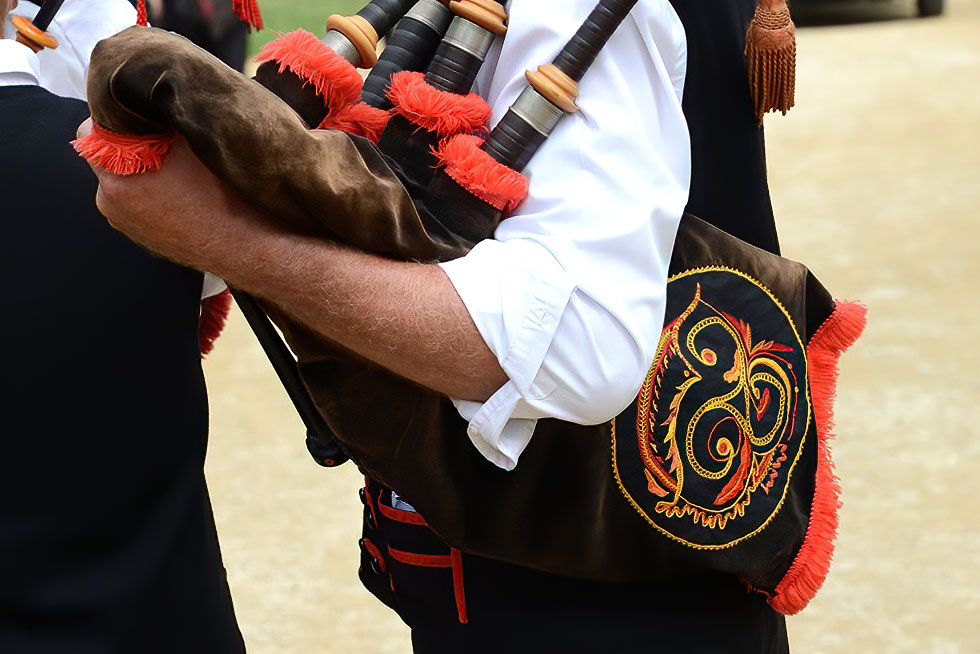
Name and Construction of the Biniou
The binioù, also known as binioù kozh (old bagpipe), is distinctive for its piercing, high-pitched sound. Traditionally crafted from animal skins and wood, the binioù features a small chanter and a single drone. The chanter, often made of boxwood, produces the melody, while the drone, set to a single pitch, provides a continuous harmonic backdrop. The bag is usually crafted from sheep or goat skin and meticulously treated to ensure airtightness and durability.
Historical Significance
The binioù has been a fixture in Breton culture for centuries. Historical records suggest that its use dates back to the medieval period when it was played at village gatherings, religious festivals, and seasonal celebrations. The binioù often accompanied another traditional Breton instrument, the bombard, a double-reed woodwind. These instruments create a robust and vibrant sound, perfect for outdoor festivities.
Traditional Music and Events
Breton music is synonymous with dance, and the binioù is at the heart of this tradition. It leads the fest-noz, night festivals where locals gather to dance traditional Breton dances such as the gavotte, hanter-dro, and an dro. These dances, characterized by their intricate steps and communal nature, celebrate Breton heritage and community spirit.
The binioù also plays a crucial role in religious and seasonal festivals. During the pardon, a traditional Breton pilgrimage, the music of the binioù guides processions, infusing the event with a sense of solemnity and celebration. In modern times, the binioù continues to thrive, embraced by musicians who blend traditional sounds with contemporary influences, ensuring its legacy endures.
Irish Bagpipes
In the emerald landscapes of Ireland, where folklore and tradition weave together, the uilleann pipes hold a place of honor. Known for their sweet, melancholic sound, these pipes capture the essence of Irish music, evoking the rolling hills and misty mornings of the Irish countryside.

Name and Construction of the Irish Bagpipe
The uilleann pipes, pronounced “ill-un“, derive their name from the Irish word for elbow, “uillean“, reflecting the method of playing them. Unlike other bagpipes, which are blown into, uilleann pipes use a bellows strapped around the waist and the arm to pump air into the bag. This allows for greater control and the ability to play a broader range of notes and dynamics.
The uilleann pipes are complex, sophisticated instruments constructed with chanters, drones, and regulators. The chanter, made of wood such as ebony or boxwood, produces the melody. The drones, typically three in number, provide a continuous harmonic backdrop. At the same time, the regulators, unique to the uilleann pipes, consist of keyed pipes that can play simple chords and rhythmic patterns. The bag is usually made from leather, meticulously crafted to ensure airtightness and ease of use.
Historical Significance
The uilleann pipes have a rich history dating back to the early 18th century. Their development is closely tied to Ireland’s social and cultural life. Unlike the warlike connotations of the Scottish Great Highland bagpipes, the uilleann pipes were designed for intimate, indoor settings. This made them popular in Irish homes and gatherings, where they were accompanied by storytelling, dancing, and singing.
Traditional Music and Events
With its lively jigs, reels, and haunting airs, Irish music finds a perfect companion in the uilleann pipes. These pipes are integral to traditional Irish sessions and informal gatherings of musicians in pubs and homes, where spontaneous and communal music-making occurs. The uilleann pipes’ ability to produce melody and harmony makes them versatile for solo performances and ensemble playing.
One of the most iconic pieces of music for the uilleann pipes is “The Coolin”, a slow air that showcases the instrument’s expressive capabilities. In addition to traditional tunes, the uilleann pipes have found their way into contemporary music, influencing genres from rock to classical.
The uilleann pipes are also central to celebrations of Irish culture, such as St. Patrick’s Day, where their music fills the air during parades and festivities. They are played at weddings, funerals, and other significant life events, underscoring their importance in Irish culture.
Italian Bagpipes
Amidst Italy’s rolling hills and sun-drenched valleys, the zampogna stands as a testament to the country’s rich pastoral traditions. This distinctive bagpipe, with its deep, resonant tones, is an integral part of Italian folk music, especially in the central and southern regions.
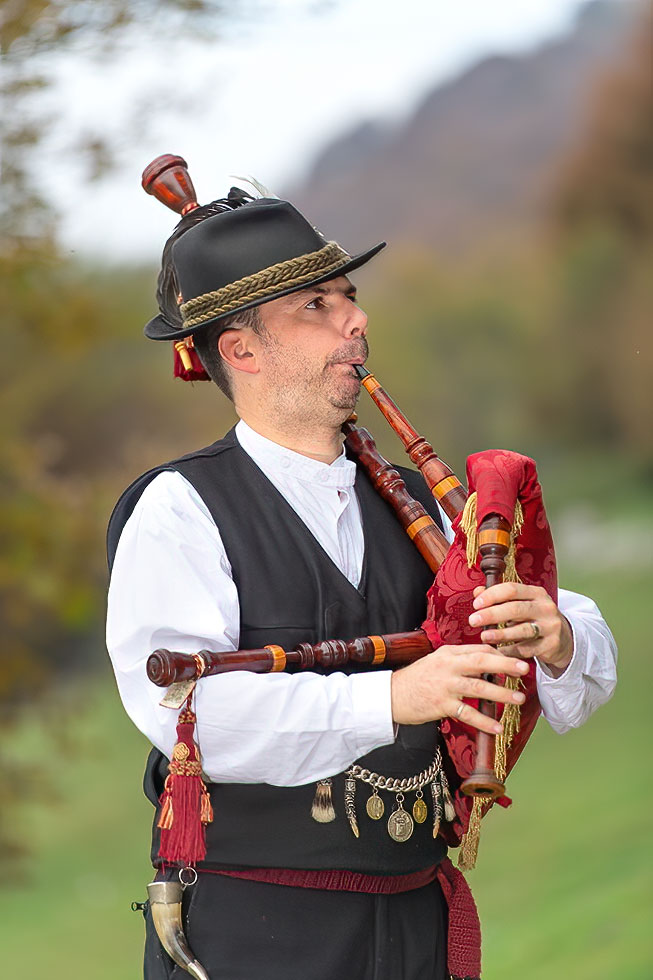
Name and Construction of the Zampogna
The zampogna, a term derived from the Italian word for “reed” or “pipe”, comes in various forms depending on the region. Typically, it features two chanters and multiple drones, which set it apart from other European bagpipes. Artisans often make the chanters and drones from locally sourced woods such as olive or boxwood, contributing to the instrument’s warm, robust sound.
Artisans intricately craft the zampogna’s bag from goat or sheep hide to maintain air tightness. They connect the pipes to the bag through wooden stocks, and the chanters, typically featuring double reeds, produce the zampogna’s characteristic-rich and layered tones. Players blow air into the bag through a mouthpiece, similar to many other bagpipes.
Historical Significance
The zampogna has deep roots in Italy’s rural life. Historical records and iconography suggest its presence in Italy since at least the Roman period. It was a favored instrument among shepherds, who played it while tending their flocks, especially during the transhumance, the seasonal movement of livestock between pastures.
During the Renaissance, the zampogna’s popularity grew, and it became a symbol of pastoral life, often depicted in art and literature of the period. Its music, often associated with the Nativity and Christmas traditions, reflects the deep connection between the instrument and the rhythms of rural life.
Traditional Music and Events
The zampogna is central to Italian folk music, particularly during the Christmas season. In regions like Abruzzo, Molise, and Calabria, zampognari (bagpipe players) herald the holiday season with their music, performing traditional carols and pastorales. One of the most famous pieces played on the zampogna is “Tu scendi dalle stelle“, a beloved Italian Christmas carol.
The instrument is also prominent in religious festivals and local fairs. For instance, during the Feast of San Rocco, zampogna led processions and provided music for the celebration. The zampogna’s evocative sound creates an atmosphere of festivity and reverence, resonating deeply with the cultural heritage of these regions.
The zampogna continues to thrive in contemporary times, with musicians and folklorists dedicated to preserving and revitalizing its traditions. The instrument’s haunting melodies can be heard in rural settings, urban folk festivals, and international music scenes, where it adds a unique Italian flavor to the global musical tapestry.
Scottish Great Highland Bagpipes
The Great Highland bagpipes have long been a symbol of national pride and cultural heritage in Scotland’s misty glens and rugged highlands. With their powerful, resonant sound, they evoke images of historic battles, grand ceremonies, and the timeless beauty of the Scottish landscape.

Name and Construction of the Scottish Pipe
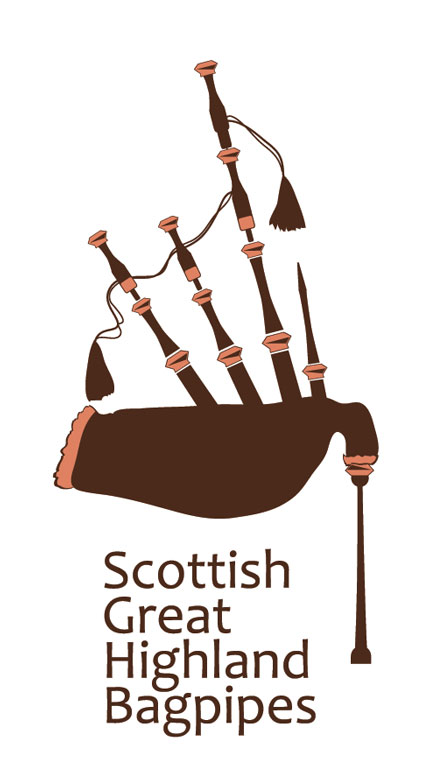
The Great Highland bagpipes, often called “the pipes”, are one of the most iconic and easily recognizable types of bagpipes. They consist of a chanter, three drones (two tenors and one bass), and a bag, typically made from synthetic materials or traditional leather. The drones and chanter are usually crafted from African blackwood, prized for its durability and rich tonal qualities.
The chanter produces the melody, while the drones provide a harmonic backdrop, each tuned to a specific pitch. The bag, inflated either by mouth or bellows, supplies a constant airflow to the pipes, allowing for the continuous sound that characterizes bagpipe music. The blowpipe, fitted with a non-return valve, ensures the bag remains inflated while the player breathes.
Historical Significance
The Great Highland bagpipes have a storied history intertwined with Scotland’s martial and cultural traditions. Historically, they were used in battle to inspire troops and intimidate enemies. One of the earliest recorded uses of the pipes in battle was at the Battle of Pinkie Cleugh in 1547, where their powerful sound played a crucial role in rallying Scottish forces.
Over time, the pipes transitioned from the battlefield to more ceremonial roles. They became central to clan gatherings, agricultural festivals, and state occasions. The 19th century saw a resurgence in their popularity, mainly due to the efforts of Queen Victoria, who embraced Scottish culture during her stays at Balmoral Castle. This period also established formal piping competitions and schools, further cementing the pipes’ place in Scottish society.
Traditional Music and Events
The repertoire of the Great Highland bagpipes is vast, encompassing lively dance tunes and haunting laments. Ceòl Mór, or “great music”, includes intricate and lengthy compositions such as pibroch, which are slow, elaborate pieces often associated with memorials and solemn events. In contrast, Ceòl Beag, or “little music”, includes marches, jigs, reels, strathspeys, and hornpipes, which are more rhythmic and upbeat.
The pipes are indispensable at Highland games, where pipers compete in solo and band events, showcasing their technical skill and musicality. They are also central to parades, military ceremonies, and state functions. One of the most poignant uses of the pipes is during funerals, where tunes like “Amazing Grace” and “Flowers of the Forest” provide a touching farewell.
In modern times, the Great Highland bagpipes have transcended their traditional roles, finding a place in contemporary music genres such as rock and classical. Bands like the Red Hot Chilli Pipers and solo artists have brought the pipes to new audiences worldwide, blending traditional sounds with modern influences.
Spanish Galician Gaita
In Spain’s diverse and storied landscapes, the bagpipe, known as the gaita, resonates through the rich tapestry of regional traditions. Each area offers its unique variant, reflecting the complex historical and cultural influences that have shaped the country. The Spanish bagpipes tell a tale of varied origins and vibrant customs from the Celtic-influenced north to the Mediterranean south.
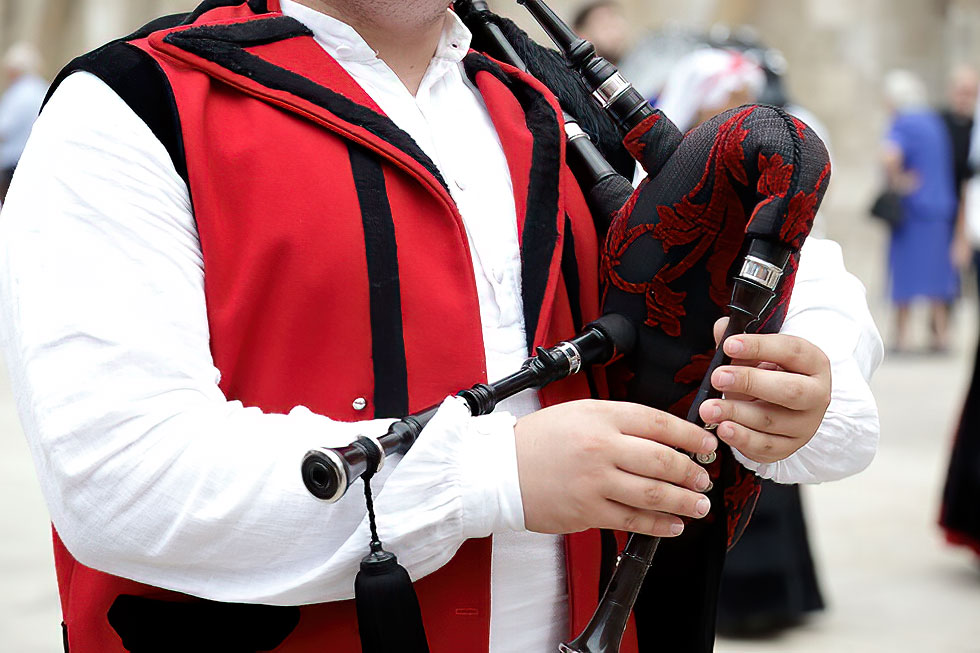
Name and Construction
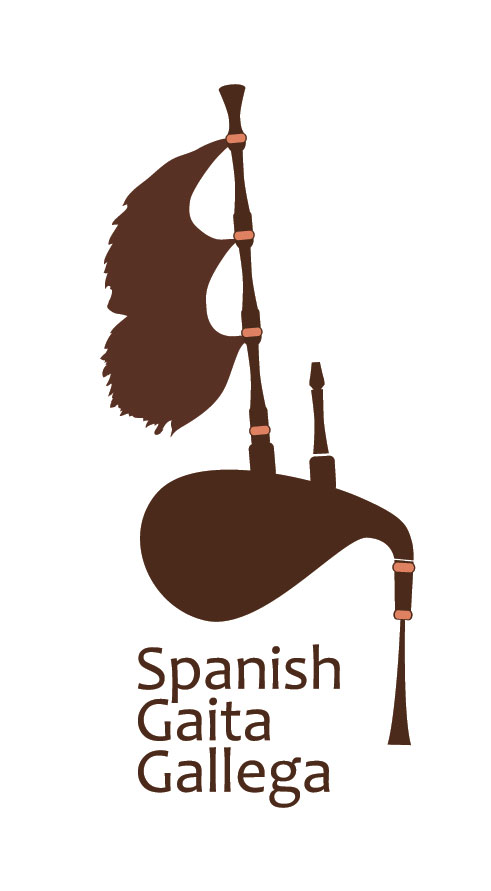
The term “gaita” itself has an uncertain origin, possibly derived from the North African “ghaita” or “rhaita“, a reed instrument related to the oboe, or from Eastern European roots, where similar instruments are known as “gajda” or “gajdy“. This ambiguity mirrors the diverse lineage of the Spanish bagpipes.
Variants and Regional Characteristics
- Gaita Gallega (Galicia): The Galician Gaita, perhaps the most well-known, features a chanter, a bass drone, and sometimes a tenor drone. It produces a bright, penetrating sound. The chanter reed is longer than its Asturian counterpart’s, and the instrument is known for its versatility in both traditional folk music and contemporary compositions.
- Gaita Asturiana (Asturias): Similar to the Galician gaita but with notable differences, the Asturian gaita has larger sound tubes and shorter reeds. It employs partially closed fingering, akin to the Irish uilleann pipes, which gives it a distinctive staccato, baroque-like sound.
- Gaita de Fole (Zamora): This variant shares similarities with the Portuguese gaita trasmontana and exhibits a scale that echoes the Scottish bagpipe. It highlights the northern influence, with its scale and construction pointing towards a Celtic connection.
- Sac de Gemecs (Catalonia): Known as the “sack of moans”, this bagpipe variant is closely related to the bagpipes of Majorca and Italy, suggesting a Mediterranean origin. It reflects the distinct cultural identity of Catalonia, both in its name and sound.
Historical Significance
The varied history of Spain, from the Celtic migrations to the Moorish conquests, has deeply influenced the evolution of its bagpipes. The Celtic heritage is vital in the north, particularly in Galicia and Asturias, where the gaita is crucial in preserving and celebrating regional identity. The influence of the Moors, who conquered southern Spain, adds another layer to the musical and cultural landscape. However, the bagpipes in these regions have different roots and characteristics than their northern counterparts.
Traditional Music and Events
Each type of Spanish bagpipe is integral to its region’s folk traditions and festivities:
- Galician Gaita: Central to the music of Galicia, the gaita is featured in traditional forms like muñeiras and alboradas. Festivals such as the Rapa das Bestas and the celebration of Saint James see gaiteros leading processions and performing in communal gatherings, blending ancient Celtic traditions with local customs.
- Asturian Gaita: The gaita asturiana accompanies dances and songs at regional festivals and cultural events in Asturias. Its distinct staccato sound adds a unique flavor to Asturian music, making it a beloved instrument for musicians and listeners.
- Zamoran Gaita de Fole: This bagpipe is prominent in the province of Zamora and is often played at local fairs and religious celebrations. Its scale and tonality resemble the Scottish bagpipe, highlighting the shared musical heritage across regions.
- Catalan Sac de Gemecs: The sac de gems is a staple in Catalonian folk music, performed at traditional festivals and cultural events. Its connection to Mediterranean bagpipes reflects the region’s unique cultural blend and maritime history.
The Spanish bagpipes, with their diverse variants and rich historical backgrounds, embody the multifaceted cultural heritage of Spain. From the Celtic-infused melodies of the north to the Mediterranean echoes of the south, each type of gaita contributes to the vibrant musical landscape of the country. Their music, deeply rooted in tradition yet ever-evolving, continues to bring people together, celebrating the unique and shared histories that define Spain.
Bulgarian Gaida
In Bulgaria’s picturesque landscapes, where the Balkan Mountains rise and the Danube flows, the gaida symbolizes Bulgarian folklore and tradition. This enchanting bagpipe, with its plaintive and expressive sound, is deeply embedded in Bulgaria’s cultural fabric, resonating through its history and into the hearts of its people.
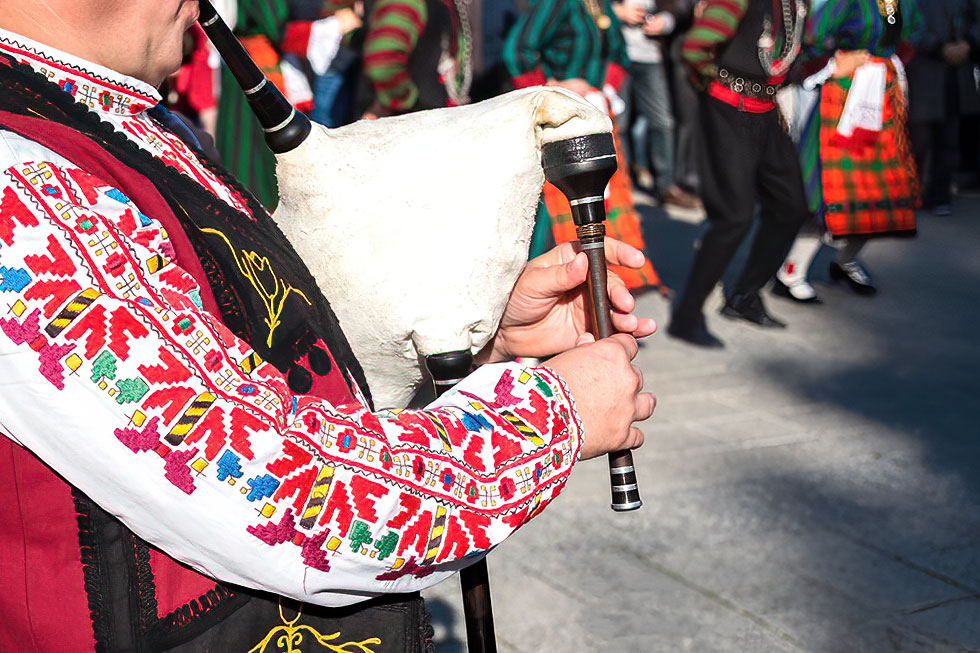
Name and Construction of the Bulgarian Gaida
Bulgarian gaida has two primary types: the higher-pitched džura gaida and the lower-pitched kaba gaida. The džura gaida is more common in northern and central Bulgaria, while the kaba gaida is native to the Rhodope Mountains in the south. Both types share a similar construction but differ in size and tuning.
The gaida is traditionally made from natural materials, with the bag crafted from the skin of a young goat or sheep. The skin is carefully treated and sewn to create an airtight reservoir. The chanter (gaidanitsa or gaidunitsa) and drone (ruchilo) are typically made from wood such as plum, boxwood, or cornel. The chanter, which produces the melody, has a single reed and is intricately carved, often with geometric patterns and traditional motifs. The drone provides a constant harmonic backdrop and is longer in the kaba gaida, contributing to its deep, resonant sound.
Historical Significance
The gaida’s history in Bulgaria stretches back over a thousand years, with evidence of its use during the First Bulgarian Empire. The instrument has always been a vital part of Bulgarian rural life, used in various aspects of daily existence, from shepherding to village celebrations.
Throughout the centuries, the gaida has been crucial in preserving Bulgarian folklore. During the Ottoman rule, when Bulgarian culture faced suppression, the gaida became a symbol of resistance and identity, keeping the spirit of Bulgarian traditions alive through its music. Legends and folklore often highlight the gaida’s importance, depicting it as a magical instrument capable of enchanting listeners and nature.
Traditional Music and Events
Bulgarian folk music is renowned for its complexity and emotional depth, with the gaida at its heart. The instrument is central to various musical forms, including horo (chain dances), rachenitsa (a lively, asymmetrical dance), and slow, haunting melodies that reflect the pastoral beauty of the Bulgarian countryside.
The gaida is indispensable at traditional festivals and life events. It is prominently featured during weddings, accompanying the bride and groom, adding a sacred and celebratory atmosphere. The gaida also plays a significant role in the traditional Kukeri festivals, where masked dancers perform rituals to ward off evil spirits and ensure a good harvest.
In the Rhodope region, the kaba gaida is particularly revered. The annual International Bagpipe Contest in Gela gathers gaidari (bagpipe players) from Bulgaria and beyond, celebrating the kaba gaida’s rich heritage. The festival, set against the stunning backdrop of the Rhodope Mountains, is a testament to the enduring legacy of the gaida in Bulgarian culture.
Modern Revival and Influence
The gaida continues to thrive in contemporary Bulgaria, and traditional musicians and modern artists embrace it. Folk ensembles and solo performers keep the traditional repertoire alive, while innovative musicians incorporate the gaida into genres like jazz, rock, and electronic music. This fusion has brought the gaida to new audiences within Bulgaria and internationally.
One notable example is the renowned Bulgarian gaida player Vassil Bebelekov, who has contributed significantly to the instrument’s revival and international recognition. His performances, solo or ensembled, highlight the gaida’s versatility and emotional power.
The gaida’s music is not just a reminder of Bulgaria’s past; it is a living, evolving art form that continues to inspire and connect people. Its plaintive tones carry the generations’ stories, hopes, and dreams, ensuring that Bulgarian music’s soul remains vibrant and alive.
The Bagpipes of Europe
Bagpipes, those ancient breath-filled vessels of melody, create a mesmerizing tapestry of sound and culture across Europe. While each type shares a common ancestry, it spins its unique thread, weaving a story rich in tradition, emotion, and community. Let us delve into the harmonious similarities that bind them and the distinctive notes that set each apart.
Shared Harmonies
Bagpipes, in their various forms, share a soul that binds them together:
- Common Construction Elements: All bagpipes consist of a bag, a chanter, and one or more drones. The bag, typically made from animal hide or synthetic materials, is an air reservoir. The chanter, where the melody is played, is universally crafted from wood, and the drones provide a continuous harmonic backdrop.
- Continuous Sound Production: The bag allows continuous sound, distinguishing bagpipes from other wind instruments. This characteristic creates the distinctive, uninterrupted musical flow that defines bagpipe music.
- Cultural and Ceremonial Roles: Across Europe, bagpipes are integral to cultural celebrations, religious festivals, and life events such as weddings and funerals. They are symbols of national or regional identity and heritage, often evoking strong emotional responses.
Distinctive Notes
Yet, within this shared heritage, each type of bagpipe sings its distinct song:
- Tuning and Pitch: The tuning and pitch of bagpipes vary significantly. The Scottish Great Highland bagpipes are known for their loud and powerful sound. This makes them suitable for outdoor performances, while the Irish uilleann pipes have a softer, more refined tone, ideal for indoor settings. The Bulgarian gaida’s rich, deep sound contrasts with the high-pitched Breton binioù.
- Playing Mechanism: Bagpipes use different methods of air supply. Scottish and Galician bagpipes are mouth-blown, while Irish uilleann pipes use a bellows system, allowing for more intricate sound control.
- Musical Repertoire: Each type of bagpipe is associated with specific musical forms and styles. The Scottish pipes are prominent in marches and pibroch, the Irish uilleann pipes in jigs and reels, and the Bulgarian gaida in horo and rachenitsa dances. These styles reflect the cultural context in which the bagpipes developed.
Interesting and Curious Facts About European Bagpipes
- Ancient Origins: Bagpipes are among the oldest musical instruments, dating back to ancient civilizations. Ancient Greece and Rome used early forms of bagpipes, indicating their long-standing presence in human history.
- Battlefield Instruments: Historically, bagpipes boosted troops’ morale and intimidated enemies in battles. The Scottish Great Highland bagpipes famously fulfilled this role, with pipers leading clans into battle.
- Royal Endorsement: Queen Victoria’s fascination with Scottish culture greatly influenced the revival of the Great Highland bagpipes in the 19th century. Her patronage helped elevate the bagpipes’ status, leading to widespread adoption in military and ceremonial contexts.
- Celtic Connections: The gaita in Galicia and the binioù in Brittany reflect the Celtic heritage shared with Irish and Scottish bagpipes. These instruments underscore the deep cultural connections across Celtic regions.
- Seasonal Celebrations: The zampogna is closely associated with Christmas traditions in Italy. Zampognari, the bagpipe players, perform pastoral carols during Advent, bringing festive cheer to towns and villages.
- Modern Innovations: Contemporary musicians have embraced bagpipes, blending traditional sounds with modern genres. Bands like the Red Hot Chilli Pipers and artists like Carlos Núñez have introduced bagpipes to new audiences, ensuring their continued relevance and popularity.
- Unique Variations: The Bulgarian kaba gaida, known for its deep, resonant sound, is unique to the Rhodope Mountains. Its size and tuning distinguish it from other bagpipes and play a vital role in the region’s musical traditions.
- Symbol of Resistance: During cultural suppression in Bulgaria, the gaida became a symbol of resistance and national identity. Through its music, it preserved the spirit of the Bulgarian people.
The Enduring Melody of Europe’s Bagpipes
Bagpipes, with their ancient origins and rich cultural significance, resonate deeply across Europe, weaving a vibrant tapestry of history, tradition, and community. From the powerful, rallying notes of the Scottish Great Highland bagpipes to the haunting, soulful melodies of the Bulgarian gaida, these instruments capture the essence of their respective regions, telling stories that span centuries.
Each type of bagpipe, whether it’s the high-pitched Breton binioù, the versatile Irish uilleann pipes, the robust Italian zampogna, or the melodic Galician gaita, reflects its homeland’s unique heritage and musical traditions. These instruments have been central to ceremonies, festivals, and daily life, marking significant events with distinctive sounds.
People cherish bagpipes in Bulgaria, its various regions, and many other European countries, such as Malta, Sweden, Latvia, Greece, North Macedonia, Finland, Estonia, Lithuania, England, Wales, and Poland. Each country has developed its bagpipe variants, contributing to a rich and diverse global bagpipe culture. From the Cornish bagpipes in England to the säckpipa in Sweden and the dudy in Poland, the diversity of bagpipes worldwide highlights this ancient instrument’s universal appeal and adaptability.
The bagpipes’ enduring presence and evolving role in modern music, from traditional folk festivals to contemporary rock and classical concerts, underscore their timeless charm and versatility. As symbols of national pride and cultural identity, bagpipes inspire and unite people, transcending geographical boundaries and connecting diverse communities through their captivating music.


